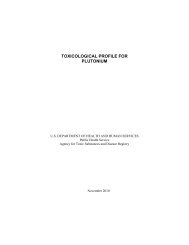BMC Evolutionary Biology
BMC Evolutionary Biology
BMC Evolutionary Biology
You also want an ePaper? Increase the reach of your titles
YUMPU automatically turns print PDFs into web optimized ePapers that Google loves.
The genera Lichanura and Charina are currently classified as erycines [1], but are strongly<br />
supported as the sister group to Ungaliophiinae, as in previous studies [20,36,47,166]. We<br />
expand Ungaliophiinae to include these two genera (Figure 21), rather than erect a new<br />
subfamily for these taxa. The subfamily Ungaliophiinae is placed as the sister group to a<br />
well-supported clade (SHL = 87) containing the rest of the traditionally recognized Erycinae<br />
and Boinae. We restrict Erycinae to the Old World genus Eryx.<br />
The genus Candoia (Boinae) from Oceania and New Guinea [1], is placed as the sister taxon<br />
to a moderately supported clade (SHL = 83) consisting of Erycinae (Eryx) and the remaining<br />
genera of Boinae (Boa, Corallus, Epicrates, and Eunectes). To solve the non-monophyly of<br />
Boinae with respect to Erycinae (due to Candoia), we place Candoia in a new subfamily<br />
(Candoiinae, subfam. nov.; see Appendix I). Boinae then comprises the four Neotropical<br />
genera that have traditionally been classified in this group (Boa, Corallus, Epicrates, and<br />
Eunectes). We acknowledge that non-monophyly of Boinae could be resolved in other ways<br />
(e.g. expanding it to include Erycinae). However, our taxonomy maintains the traditionally<br />
used subfamilies Boinae, Erycinae, and Ungaliophiinae, modifies them to reflect the<br />
phylogeny, and recognizes the phylogenetically distinct boine clades as separate subfamilies<br />
(Candoiinae, Sanziniinae). Within Boinae, Eunectes renders Epicrates paraphyletic, but this<br />
is not strongly supported see also ([48]).<br />
Our results for advanced snakes (Caenophidia) are generally similar to those of other recent<br />
studies [41,42,169], and will only be briefly described. However, in contrast to most recent<br />
studies [20,36,41,42,81,159,160], Acrochordidae is here strongly placed (SHL = 95) as the<br />
sister group to Xenodermatidae. This clade is then the sister group to the remaining<br />
Colubroidea, which form a strongly supported clade (SHL = 100; Figures 1, 22). This<br />
relationship has been found in some previous studies [169,170], and was hypothesized by<br />
early authors [171]. Further evidence will be required to resolve this conclusively. Analyses<br />
based on concatenation of 20–44 loci do not support this grouping [20,36], though<br />
preliminary species-tree analyses of >400 loci do (Pyron et al., in prep.). Relationships in<br />
Pareatidae are similar to recent studies [172], and the group is strongly placed as the sister<br />
taxon to colubroids excluding xenodermatids (SHL = 100; Figures 1 , 22), as in most recent<br />
analyses (e.g. [41,43,44]).<br />
The family Viperidae is the sister group to all colubroids excluding xenodermatids and<br />
pareatids (Figure 1), as in other recent studies. The family Viperidae is strongly supported<br />
(Figure 22), as is the subfamily Viperinae, and the sister-group relationship between<br />
Azemiopinae and Crotalinae (SHL = 100). Our results generally support the existing genericlevel<br />
taxonomy within Viperinae (Figure 22). However, we recover a strongly supported<br />
clade within Viperinae consisting of Daboia russelii, D. palaestinae, Macrovipera<br />
mauritanica, and M. deserti (Figure 22), as in previous studies [173]. We corroborate<br />
previous suggestions that these taxa be included in Daboia [174], though this has not been<br />
widely adopted [1]. The other Macrovipera species (including the type species) remain in that<br />
genus (Figure 22).<br />
Within Crotalinae (Figure 22), a number of genera appear to be non-monophyletic. The<br />
species Trimeresurus gracilis is strongly supported as the sister taxon to Ovophis okinavensis<br />
and distantly related to other Trimeresurus, whereas the other Ovophis are strongly placed as<br />
the sister group to Protobothrops. A well-supported clade (SHL = 90) containing Atropoides<br />
picadoi, Cerrophidion, and Porthidium renders Atropoides paraphyletic (see also [175]). The<br />
species Bothrops pictus, considered incertae sedis in previous studies [176], is here strongly



